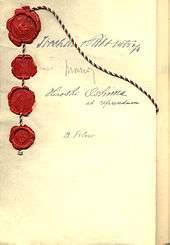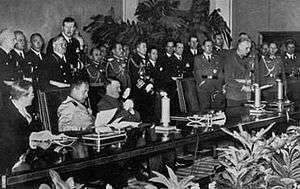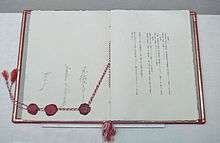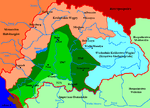Tripartite Pact
|
Signing of the Tripartite Pact. On the lefthand side of the picture, seated from left to right, are: Saburō Kurusu (representing Japan), Galeazzo Ciano (Italy) and Adolf Hitler (Germany). | |
| Type | Military alliance |
|---|---|
| Signed | 27 September 1940 |
| Location | Berlin, Germany |
| Signatories | |
The Tripartite Pact, also known as the Berlin Pact, was an agreement between Germany, Japan and Italy signed in Berlin on 27 September 1940 by, respectively, Joachim von Ribbentrop, Saburō Kurusu and Galeazzo Ciano. It was a defensive military alliance that was eventually joined by Hungary (20 November 1940), Romania (23 November 1940), Bulgaria (1 March 1941) and Yugoslavia (25 March 1941), as well as by the German client state of Slovakia (24 November 1940). Yugoslavia's adherence provoked a coup d'état in Belgrade, and Italy and Germany responded by invading Yugoslavia (with Bulgarian, Hungarian and Romanian assistance) and partitioning the country. The resulting Italo-German client state of Croatia joined the pact on 15 June 1941.
The Tripartite Pact was directed primarily at the United States. Its practical effects were limited, since the Italo-German and Japanese operational theatres were on opposite sides of the world and the high contracting powers had disparate strategic interests. Some technical cooperation was carried out, and the Japanese declaration of war on the United States propelled, although it did not require, a similar declaration of war from all the other signatories of the Tripartite Pact.
Text of the pact
Japanese version of the Tripartite Pact, 27 September 1940.The Governments of Japan, Germany, and Italy consider it as the condition precedent of any lasting peace that all nations in the world be given each its own proper place, have decided to stand by and co-operate with one another in their efforts in Greater East Asia and the regions of Europe respectively wherein it is their prime purpose to establish and maintain a new order of things, calculated to promote the mutual prosperity and welfare of the peoples concerned. It is, furthermore, the desire of the three Governments to extend cooperation to nations in other spheres of the world that are inclined to direct their efforts along lines similar to their own for the purpose of realizing their ultimate object, world peace. Accordingly, the Governments of Japan, Germany and Italy have agreed as follows:[1]
ARTICLE 1. Japan recognizes and respects the leadership of Germany and Italy in the establishment of a new order in Europe.
ARTICLE 2. Germany and Italy recognize and respect the leadership of Japan in the establishment of a new order in Greater East Asia.
ARTICLE 3. Japan, Germany, and Italy agree to cooperate in their efforts on aforesaid lines. They further undertake to assist one another with all political, economic and military means if one of the Contracting Powers is attacked by a Power at present not involved in the European War or in the Japanese-Chinese conflict.
ARTICLE 4. With a view to implementing the present pact, joint technical commissions, to be appointed by the respective Governments of Japan, Germany and Italy, will meet without delay.
ARTICLE 5. Japan, Germany and Italy affirm that the above agreement affects in no way the political status existing at present between each of the three Contracting Powers and Soviet Russia.
ARTICLE 6. The present pact shall become valid immediately upon signature and shall remain in force ten years from the date on which it becomes effective. In due time, before the expiration of said term, the High Contracting Parties shall, at the request of any one of them, enter into negotiations for its renewal.
In faith whereof, the undersigned duly authorized by their respective governments have signed this pact and have affixed hereto their signatures.
Done in triplicate at Berlin, the 27th day of September, 1940, in the 19th year of the fascist era, corresponding to the 27th day of the ninth month of the 15th year of Showa (the reign of Emperor Hirohito).
Background of the original agreement

The pact supplemented the Anti-Comintern Pact of 1936 and helped heal the rift that had developed between Japan and Germany following the 1939 Molotov–Ribbentrop Pact between Germany and the Soviet Union.
Later signatories
Hungary
The Austro-Hungarian Empire had sided with Imperial Germany during World War I and had collapsed following the defeat by the Allies. Following the Treaty of Trianon, the Kingdom of Hungary was reduced greatly in size and this caused much resentment. To assuage this resentment, Germany and Italy implemented the First and Second Vienna Awards in 1938 and 1940; these were followed by Hungary joining the Tripartite Pact on November 20, 1940. Collusion was further heightened when the Fascist Arrow Cross Party later came to power.
Romania
The Kingdom of Romania had joined the Allied Powers in World War I and had received Transylvania from Austria–Hungary. After Germany and Italy awarded parts of Transylvania back to Hungary and Southern Dobruja back to Bulgaria and after the Soviet Union had taken Bessarabia and Northern Bukovina, the Fascist Iron Guard party came to power and Romania joined the Tripartite Pact on November 23, 1940. This was due to the Romanian desire for protection against the Soviet Union.
Slovakia
On 14 March 1939, the Slovak Republic was declared in the midst of the dismemberment of Czechoslovakia. Hitler invited Monsignor Jozef Tiso to be the new nation's leader. Soon after it was formed, Slovakia was involved in a war with neighboring Hungary. Although Slovakia had signed a "Protection Treaty" with Nazi Germany, Germany refused to intervene. The war resulted in territorial gains by Hungary at Slovakia's expense. Even so, Slovakia supported the German invasion of Poland in 1939.
On 24 November 1940, the day after Romania signed the pact, the Slovak prime minister and foreign minister, Vojtech Tuka, went to Berlin to meet Ribbentrop. There he signed Slovakia's adherence to the Tripartite Pact. The purpose of this was to increase Tuka's standing in Slovakia relative to that of his rival, Tiso, although the Germans had no intention of permitting Tiso to be removed.[2]
Bulgaria

The Kingdom of Bulgaria had been on the losing side in World War I, losing territory to Serbia and Greece. During World War II, Germany needed military access through Bulgaria in order to attack Greece. Adolf Hitler promised the Bulgarian Tsar Boris III that Bulgaria would receive all the territory she had lost in return for Bulgaria joining the Axis. Boris agreed and prime-minister Bogdan Filov signed the Pact on March 1, 1941.
Yugoslavia
On March 25, 1941 in Vienna, Dragiša Cvetković, Prime Minister of the Kingdom of Yugoslavia, signed the Tripartite Pact. On March 27, the regime was overthrown in a military coup d'état with British support. The 17-year-old King Peter II of Yugoslavia seized power. General Dušan Simović became Peter's Prime Minister and the Kingdom of Yugoslavia initially tried to dissolve the Pact but later declared adherence to it.
The initial agreement of the document also regarded Yugoslavia's acceptance of the free movement of German troops around the country; this was unsatisfactory to the Führer, and resulted in the Invasion of Yugoslavia.
Postponing Operation Barbarossa, the Germans simultaneously attacked Yugoslavia and Greece. Starting on April 6, the German Air Force bombed Belgrade for three days and nights. German ground troops (Wehrmacht Heer) moved in, and Yugoslavia capitulated on April 17.
Croatia
The Independent State of Croatia (Nezavisna Država Hrvatska, or NDH) signed the Tripartite Pact on 15 June 1941.[3]
Potential signatories
Soviet Union
Just prior to the formation of the Tripartite Pact, the Soviet Union was informed of its existence, and the potential of its joining.[4] Vyacheslav Molotov was thus sent to Berlin to discuss the pact and the possibility of the Soviet Union joining it.[4] For the Soviets, they considered joining the Tripartite Pact to be an update of existing agreements with Germany.[4] On Molotov's visit, he agreed in principle to the Soviet Union joining the pact so long as some details, such as Soviet annexation of Finland, could be worked out.[4] The Soviet government sent a revised version of the pact to Germany on November 25.[4] To demonstrate the benefits of partnership, the Soviet Union made large economic offerings to Germany.[4]
Regardless of the talks however, the Germans had no intention of allowing the Soviets to join the pact. They were already in the preparation stages for their invasion of the Soviet Union and were committed to doing so regardless of any action the Soviets took.
Political conversations designed to clarify the attitude of Russia in the immediate future have been started. Regardless of the outcome of these conversations, all preparations for the East previously ordered orally are to be continued. [Written] directives on that will follow as soon as the basic elements of the army's plan for the operation have been submitted to me and approved by me. —Adolf Hitler[4]
When they received the Soviet offer in November, they simply did not reply. They did, however, accept the new economic offerings, and signed an agreement for such on January 10, 1941.[4]
Finland
Military co-operation between Finland and Nazi Germany started in late 1940 after Finland had lost a significant amount of her territory to Soviet aggression in the Winter War. Finland joined Operation Barbarossa on June 25, 1941, starting the Continuation War. In November, Finland signed the Anti-Comintern Pact (an anti-communist agreement directed against the Soviet Union) with many other countries allied with Germany. Soon after this Germany suggested Finland sign the Tripartite Pact. However, the Finnish government refused, because Finland saw its war as a "separate war" from the Second World War, and it saw its objectives as different from those of Nazi Germany. Finland also wanted to maintain diplomatic relations with the Allied Powers, the United States in particular. During the Second World War, Germany asked Finland several times to sign the pact, but always the Finnish government declined the offer. Diplomatic relations between Finland and the United States were maintained until June 1944, although the US ambassador had already been recalled earlier. The United Kingdom, however, declared war on Finland on 6 December 1941 in support of its ally, the Soviet Union.
At the request of the German command, the Finns established a winter warfare school in Kankaanpää. It began its first two-month course for German officers and NCOs in December 1941. In the summer of 1942, the German-speaking Finnish instructors taught a course on forest warfare. General Waldemar Erfurth, the German liaison to the Finnish general headquarters, considered the school an outstanding success. It was also attended by some Hungarian officers.[5]
Thailand
Japan attacked Thailand at 2:00 a.m. local time on 8 December 1941. The Japanese ambassador, Teiji Tsubokami, told the Thai foreign minister, Direk Jayanama, that Japan only wanted permission for its troops to pass through Thailand to attack the British in Malaya and Burma. At 7:00 a.m., Prime Minister Plaek Phibunsongkhram (Phibun) held an emergency cabinet meeting in Bangkok and soon after a ceasefire was ordered. Phibun then met with Tsubokami, who offered him four options: to conclude a defensive–offensive alliance with Japan, to join the Tripartite Pact, to cooperate in Japanese military operations, or to agree to the joint defence of Thailand. Military cooperation was chosen, the Tripartite Pact rejected.[6]
According to the post-war memoires of Direk Jayanama, Phibun planned to later sign the pact, but Direk's opposition prevented this.[7]
Tripartite relations, 1940–43
The "joint technical commissions" required by the pact were established by an agreement of 20 December 1940. They were to consist of a general commission in each capital, consisting of the host foreign minister and the other two partners' ambassadors. Under the general commission were to be military and economic commissions. On 15 December 1941 the first meeting of all three commissions in one capital, Berlin, took place, labelled a "Tripartite Pact Conference". It was decided there to form a "Permanent Council of the Tripartite Pact Powers", but nothing happened for two months. Only the Italians, whom the Japanese mistrusted, pushed for greater collaboration.[8]
On 18 January 1942, the German and Italian governments signed two secret operational agreements, one with the Imperial Japanese Army and another with the Imperial Japanese Navy. These agreements divided the world along longitude 70° east into two major operational zones, but it had almost no military significance. Chiefly, it committed the powers to cooperation in matters of commerce, intelligence and communication.[8]
On 24 February 1942 the Permanent Council met under the chairmanship of Ribbentrop, who announced that "the propaganda effect is one of the main reasons for our meetings". The representatives set up a propaganda commission and then adjourned indefinitely. The military commission in Berlin met only two or three times by 1943, and there were no trilateral naval talks at all. Germany and Japan conducted separate naval discussions, and Italy consulted the Japanese independently for its planned assault on Malta in 1942.[8]
The economic relationship between the Tripartite powers was fraught with difficulty. Japan would not grant economic concessions to Germany in 1941, lest they ruin its negotiations with the United States. In January 1942 negotiations on economic cooperation began, but an agreement was not signed until 20 January 1943 in Berlin. Italy was invited to sign a similar agreement in Rome at the same time, for propaganda purposes, but none of the supplementary Berlin protocols applied to Italo-Japanese relations.[8]
"No separate peace" agreement
Japan first pressed Germany to join the war with the United States on 2 December 1941, only two days after notifying Berlin of its intention to go to war. Receiving no response, Japan approached Italy. At 0400 hours on the morning of 5 December, Ribbentrop gave the Japanese ambassador a proposal—which had already been approved by Italy—to join the war and prosecute it jointly. On 11 December 1941, the same day as the German declaration of war against the United States and the Italian declaration, the three powers signed an agreement—already hammered out on 8 December—barring any separate peace with the United States or Britain. It was "intended as a propaganda accompaniment to the declaration of war".[8]
ARTICLE I. Italy, Germany and Japan will henceforth conduct in common and jointly a war which has been imposed on them by the United States of America and England, by all means at their disposal and until the end of hostilities.
ARTICLE II. Italy, Germany and Japan undertake each for himself that none of the parties to the present accord will conclude either armistice or peace, be it with the United States or with England without complete and reciprocal agreement [of the three signatories to this pact].
ARTICLE III. Italy, Germany and Japan, even after the victorious conclusion of this war, will collaborate closely in the spirit of the Tripartite Pact, concluded Sept. 21, 1940, in order to realize and establish an equitable new order in the world.
ARTICLE IV. The present accord is effective immediately on its signature and remains in force for the duration of the Tripartite Pact, signed Sept. 27, 1940. The high contracting parties of this accord will at an opportune moment agree among themselves the means of implementing Article III above of this accord.[9]
References
- ↑ "Three-Power Pact Between Germany, Italy, and Japan, Signed at Berlin, September 27, 1940". Avalon Law Project. Retrieved 23 November 2013.
- ↑ Jelínek 1971, p. 255.
- ↑ Kolanović 2006, p. 473.
- 1 2 3 4 5 6 7 8 Weinberg 1994, pp. 199–202.
- ↑ DiNardo 1996, p. 713.
- ↑ Chinvanno 1992, p. 13.
- ↑ Flood 1970, p. 989.
- 1 2 3 4 5 Boog et al. 2001.
- ↑ "Pact Between the Axis Powers Barring a Separate Peace with the United States or Great Britain; December 11, 1941". Avalon Law Project. Retrieved 29 November 2014.
Sources
- Bán, András D. (2004). Hungarian–British Diplomacy, 1938–1941: The Attempt to Maintain Relations. Translated by Tim Wilkinson. London: Frank Cass. ISBN 0714656607.
- Chinvanno, Anuson (1992). Thailand’' Policies towards China, 1949–54. Macmillan.
- Flood, E. Thadeus (1970). "Review of Thailand and the Second World War by Direk Chayanam". The Journal of Asian Studies. 29 (4): 988–90. doi:10.2307/2943163.
- Boog, Horst; Rahn, Werner; Stumpf, Reinhard; et al., eds. (2001). Germany and the Second World War, Volume 6: The Global War. Oxford University Press. Retrieved 29 November 2014.
- DiNardo, R. L. (1996). "The Dysfunctional Coalition: The Axis Powers and the Eastern Front in World War II". The Journal of Military History. 60 (4): 711–30. doi:10.2307/2944662.
- Giurescu, Dinu C. (2000). Romania in the Second World War (1939–1945). Boulder, CO: East European Monographs.
- Jelínek, Yeshayahu (1971). "Slovakia's Internal Policy and the Third Reich, August 1940 – February 1941". Central European History. 4 (3): 242–70. doi:10.1017/s0008938900015363.
- Kolanović, Nada Kisić (2006). "The NDH's Relations with Southeast European Countries, Turkey and Japan, 1941–45". Totalitarian Movements and Political Religions. 7 (4): 473–92. doi:10.1080/14690760600963248.
- Macartney, C. A. (1956). October Fifteenth: A History of Modern Hungary, 1929–1945. vol. 1. Edinburgh: Edinburgh University Press.
- Miller, Marshall Lee (1975). Bulgaria during the Second World War. Stanford, CA: Stanford University Press.
- Weinberg, Gerhard L. (1994). A World at Arms: A Global History of World War II. Cambridge University Press. ISBN 978-0-521-61826-7.
External links
| Wikimedia Commons has media related to Tripartite Pact. |


